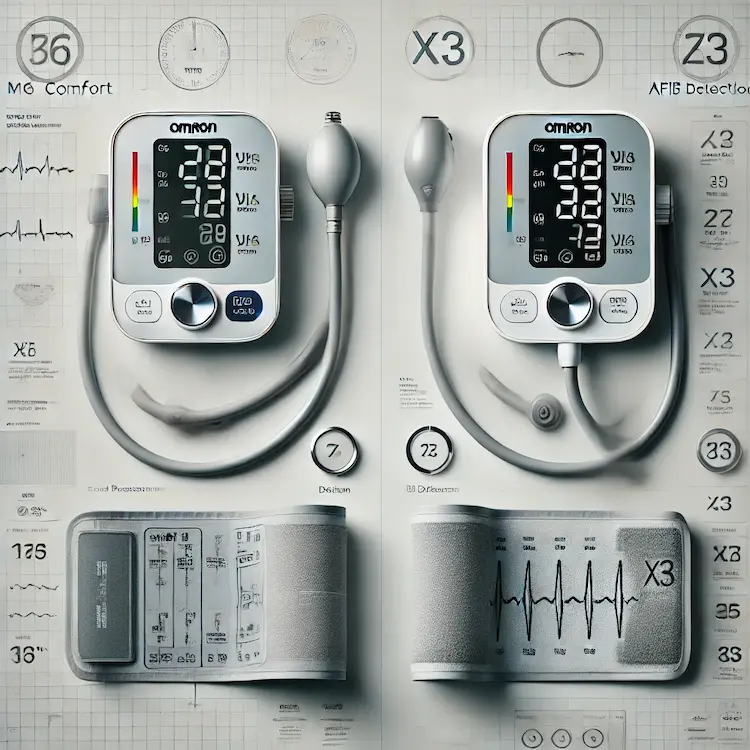Atrial fibrillation (AFIB) is a major risk factor for stroke, heart failure, and other cardiovascular complications. With millions of people globally at risk, early detection of AFIB through home blood pressure monitors is crucial. Omron, a trusted brand in medical technology, offers several blood pressure monitors with AFIB detection capabilities, including the Omron M6 Comfort and Omron X3.
Both models promise accurate readings and reliable performance, but which one is more effective for AFIB detection? This article provides a comprehensive comparison of the Omron M6 Comfort and Omron X3, evaluating their accuracy, features, usability, and overall value for individuals at risk of AFIB.
Understanding AFIB and the Importance of Home Detection
What is Atrial Fibrillation (AFIB)?
Atrial fibrillation (AFIB) is an irregular and often rapid heart rhythm that increases the risk of stroke, heart failure, and other heart-related complications. AFIB occurs when the heart’s upper chambers (atria) beat irregularly, disrupting blood flow and increasing the likelihood of clot formation.
Why Early Detection Matters
- Higher Stroke Risk: AFIB patients are 5 times more likely to have a stroke.
- Often Asymptomatic: Many people with AFIB do not experience noticeable symptoms.
- Silent Progression: Without early detection, AFIB can lead to serious cardiovascular issues.
How Blood Pressure Monitors Help
Blood pressure monitors with AFIB detection use oscillometric technology to analyze pulse waves and identify irregularities. Devices like the Omron M6 Comfort and Omron X3 integrate AFIB detection into their measurements, providing a convenient at-home screening tool.

Omron M6 Comfort vs. Omron X3: A Feature-by-Feature Comparison
| Feature |
Omron M6 Comfort |
Omron X3 |
| AFIB Detection |
Yes, with enhanced accuracy |
Yes, standard detection |
| Cuff Type |
Intelli Wrap Cuff (22-42 cm) |
Standard Cuff (22-42 cm) |
| Memory Storage |
2 Users, 100 readings each |
2 Users, 30 readings each |
| Average Mode |
3 consecutive readings |
3 consecutive readings |
| Validation |
Clinically validated |
Clinically validated |
| Ease of Use |
Advanced usability |
Basic usability |
| Connectivity |
No Bluetooth |
No Bluetooth |
| Price |
Higher (~€90-€110) |
Lower (~€50-€70) |
Accuracy and AFIB Detection
Both devices detect irregular heart rhythms, but Omron M6 Comfort provides enhanced accuracy due to its Intelli Wrap Cuff technology. This ensures that cuff placement errors do not affect measurement accuracy—something common with standard cuffs like the one on the Omron X3.
Cuff Technology: Intelli Wrap vs. Standard Cuff
- Omron M6 Comfort: Features the Intelli Wrap Cuff, which minimizes errors due to incorrect placement.
- Omron X3: Uses a standard cuff, which requires precise positioning for accurate readings.
Memory and Multi-User Functionality
- Omron M6 Comfort: Stores 100 readings per user (2 users), making it ideal for long-term tracking.
- Omron X3: Stores 30 readings per user, which may be insufficient for extended monitoring.
Clinical Validation and Reliability
Both monitors are clinically validated for accuracy, meaning they meet international hypertension measurement standards. However, Omron M6 Comfort has enhanced accuracy due to its cuff technology and improved algorithm.
Usability and Display
- Omron M6 Comfort: Features a larger, clearer display and intuitive buttons.
- Omron X3: Has a smaller, simpler screen, making it less user-friendly for seniors or those with vision impairments.
Price and Value for Money
- Omron M6 Comfort is more expensive (€90-€110) but provides higher accuracy and better usability.
- Omron X3 is budget-friendly (€50-€70) but lacks advanced cuff technology.
Which Monitor is More Effective for AFIB Detection?
Best for High Accuracy and Usability → Omron M6 Comfort
The Omron M6 Comfort offers superior AFIB detection accuracy, thanks to its Intelli Wrap Cuff and advanced measurement algorithm. It is ideal for patients who require precise, consistent readings and those with hypertension or irregular heartbeat history.
Best for Budget-Friendly AFIB Screening → Omron X3
The Omron X3 is a reliable entry-level AFIB detection monitor, making it suitable for casual users or those on a budget. While it lacks advanced cuff technology, it still provides clinically validated results.

Practical Tips for Effective AFIB Detection at Home
- Use the Right Cuff: Incorrect cuff placement can lead to inaccurate readings. If struggling with positioning, consider Omron M6 Comfort for its Intelli Wrap Cuff.
- Measure at the Right Time: Take readings twice daily (morning and evening) for consistent results.
- Avoid Movement and Talking: Remain still and do not speak while measuring blood pressure.
- Track Your Readings: Keep a log of AFIB detections and consult a doctor if irregularities persist.
- Follow a Heart-Healthy Lifestyle: Manage risk factors like high blood pressure, obesity, and stress to prevent AFIB complications.
Conclusion
Both Omron M6 Comfort and Omron X3 are effective for AFIB detection, but their suitability depends on the user’s needs:
- Choose Omron M6 Comfort for high accuracy, long-term tracking, and advanced usability.
- Choose Omron X3 for budget-friendly, basic AFIB detection with clinically validated performance.
For individuals at high risk of AFIB or stroke, the Omron M6 Comfort is the better choice, while casual users may find the Omron X3 sufficient.
Key Takeaways:
- AFIB detection is essential for stroke prevention.
- Omron M6 Comfort offers higher accuracy due to Intelli Wrap Cuff.
- Omron X3 is a budget-friendly alternative with standard AFIB detection.
- Long-term tracking is easier with Omron M6 Comfort (100 readings vs. 30).
- Proper measurement techniques enhance AFIB detection reliability.
Actionable Recommendations:
- If you have high AFIB risk, choose Omron M6 Comfort.
- If you need basic AFIB detection, the Omron X3 is sufficient.
- Maintain a consistent monitoring routine for reliable results.
- Consult a doctor if AFIB is detected repeatedly.

